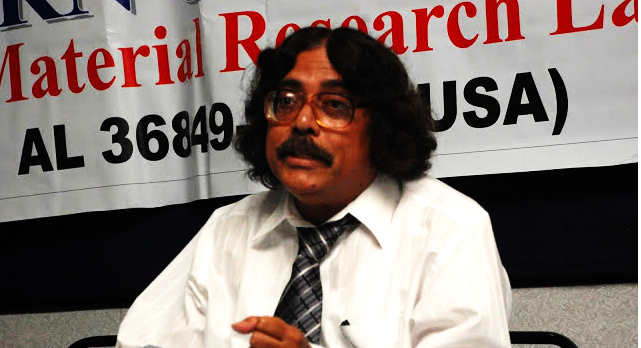AN ACADEMIC INJUSTICE MADE TO PREVAIL: CASE OF PROFESSOR MRINAL THAKUR

Royal Swedish Academy of Sciences Agrees the Basic Assumption in 2000 Nobel Prize in Chemistry is Incorrect and there was Plagiarism in the 2014 Nobel Prize, but has not yet taken any action to make the requisite Corrections and provide Due Credit to Professor Mrinal Thakur.
Kolkata, August 15, 2023: In a statement here, Professor Mrinal Thakur said, while The Royal Swedish Academy of Sciences is in agreement that the basic scientific assumption in the 2000 Nobel Prize in Chemistry is incorrect and plagiarism was a critical issue in the case of 2014 Nobel Prize, the Academy has not taken any initiative to make requisite corrections and provide the credit to him.
Currently working as the Director of Photonic Materials Research Laboratory at Auburn University (USA), by the Royal Swedish Academy of Sciences (RSAS), Professor Thakur was nominated for the Chemistry Nobel Prize by the scientific academia for 22 times. Thakur’s Equartion has been acclaimed globally as based on his scientific theory on nonlinear optics providing quantitative measure of super-resolution depending on laser pulse intensity.
As it appears at the website of The Nobel Foundation,“ key property of a conductive polymer is the presence of conjugated double bonds along the backbone of the polymer. In conjugation, the bonds between the carbon atoms are alternately single and double.” Also, “For a polymer to be able to conduct electric current it must consist alternately of single and double bonds between carbon atoms”. These fundamental statements are nonfactual / incorrect since these disregard existence of “Nonconjugated” Conductive Polymers and their impact.
The RSAS gave the Chemistry Nobel Prize to Heeger, MacDiarmid and Shirakawa for the discovery of “Conjugated Polymers” while they discovered only the “Conjugated” conductive polymers. But the discovery of “Nonconjugated” Conductive Polymers by Professor Thakur was ignored.
If Heeger, MacDiarmid and Shirakawa received the Nobel Prize in Chemistry for the discovery of “Conjugated” conductive polymers, why Professor Thakur not being recognized for his discovery of the “Nonconjugated” Conductive Polymers? He demands immediate recognition of the “Correct” basic assumption made by him.
Professor Thakur used Coulomb Correlation theory which applies to both Nonconjugated and Conjugated Conductive Polymers while other theories developed only considering Conjugated Conductive Polymers may lead to incorrect conclusions. “Conjugated” conductive polymer indeed is a special case of “Nonconjugated” conductive polymer.
Professor Thakur discovered “Nonconjugated” Conductive Polymers around the same time as that of the discovery of “Conductive Polymers” by Heeger, MacDiarmid and Shirakawa. Here, the blatant violation of academic norms comes to light.
As stated earlier. though the RSAS is in agreement with Professor Thakur that the fundamental basis given in the document preserved for the 2000 Nobel Prize in Chemistry is incorrect / nonfactual, the RSAS has not taken steps to make requisite corrections and accord due credit to Professor Thakur.
Professor Thakur also stated that those receiving the Chemistry Nobel Prize in 2014 did so by plagiarizing from his experimental and theoretical works in nonlinear optics.
Thakur’s Equation on Super-resolved Fluorescence Microscopy
The 2014 Nobel Prize in Chemistry was awarded to Betzig, Hell and Moerner for their works on “Super-Resolved Fluorescence Microscopy.”
The central equation (Equation 3 in 2014 Nobel document) used in this work is based on nonlinear optics works and phase-space-filling model developed by Professor Thakur and coworkers. No reference of that is given in the 2014 Nobel document preserved at the Nobel Foundation website.
Detailed nonlinear optical coefficients as a function of wavelength, excited-state lifetimes, two-photon absorption and the detailed saturation dynamics have all been measured by Professor Thakur and coworkers using femtosecond-duration pulses and their theoretical interpretations have been established. The excited state lifetime as measured is about 1.8 ps. In the off-resonant domain the response is instantaneous.
As discussed in such reports, (phase-space filling model applied to PTS-polydiacetylene crystal), the fractional change in oscillator strength, δf/f is related to the number fraction of electrons (excitons) involved in the transitions is as given in the following: δf/f = – N/Ns where Ns is the saturation density.
For organic materials, energy levels remain essentially unchanged when light is incident on it.
Using the phase-space filling model as above verified by detailed experimental measurements (Thakur et al. 1985-88), the equation relating the resolution and laser light intensity (Thakur’s Equation) that one arrives at is Δ = λ/(2nsinα(1 + I/Is)1/2).
Here Δ stands for resolution, I stands for laser light intensity, λ is wavelength, n is refractive index, α is semi-aperture angle and Is is saturation intensity. More details of the equation have recently appeared (Thakur, J. Macromol. Sci., PAC 2016 and references therein).
This is the central equation, Equation 3 given in page 5 of the 2014 Nobel document preserved at the Nobel Foundation website and is derived based on phase-space filling model and the statistics involved in the emission process.
No reference for this equation was provided in that document. Professor Thakur received no credit from RSAS in 2014 Nobel Prize!
These violations of both the academic standards and human rights resulted in staging demonstrations in New Delhi and Mumbai by the Indian public. However, the RSAS ignored those by continuing to deprive Professor Thakur of his justified claims in the Chemistry Nobel Prize.
Earlier, Professor Thakur requested the Prime Ministers of Sweden and India and the President of USA to take up the long pending issues with the RSAS to arrive at meaningful resolutions – nothing has transpired as yet!
The Nobel Committee failed to follow their statutes (Statutes of The Nobel Foundation) in decisions on 2000 and 2014 Nobel Prizes in Chemistry. The relevant statute (1) goes as follows: the prize will go “to the person who shall have made the most important chemical discovery or improvement”. Can “incorrect” or “plagiarized” works be considered “most important chemical discovery”? Not really!
The research conducted by Professor Thakur proved the “Nonconjugated Conductive Polymers” can effectively absorb radioactive iodine emitted from nuclear reactors saving the Mother Earth. Millions of human lives, flora and fauna across the globe can be safeguarded by creating shields made of the Nonconjugated Conductive Polymers.
Mass deployment of such shields can protect the people against radiation poisoning and different ailments including thyroid cancer that radioactive iodine causes. Currently, there is a huge demand for the potassium-iodide pills throughout the European Union (EU) for fear of nuclear radiation due to the ongoing Ukraine-Russia war.
In the backdrop of this fear of nuclear war, the world leaders should try to impress upon the RSAS to recognize the radiation absorbing capacity of the “Nonconjugated” Conductive Polymer-based shielding technology. The global leaders must come forward in sealing all nuclear reactor facilities around the world with this protective shield to save human lives.
It is in this backdrop that Professor Thakur demands immediate resolution to the four critical issues which have remained unaddressed for long many years:
1) No credit was given to Professor Thakur in 2000 Nobel Prize and afterwards for his discovery of “Nonconjugated Conductive Polymers.”
2) Royal Swedish Academy is yet to correct the document preserved at the Nobel Foundation website despite repeated requests. The document states a polymer must be conjugated to be electrically conductive – which is nonfactual and the corresponding theory as given is incorrect / inapplicable,
3) Professor Thakur’s research funding was abruptly stopped in 2003 as he brought up the incorrectness and inequity regarding the 2000 Nobel Prize in Chemistry.
4) Professor Thakur stakes claim to the 2014 Nobel Prize in Chemistry as well since “Super-resolved Fluorescence Microscopy” (2014 Nobel in Chemistry) is primarily based on earlier nonlinear optical experimental and theoretical studies performed by Professor Thakur and colleagues on organic materials.
Professor Thakur did not receive credit in the 2000 Nobel Prize. Again in 2014, the Nobel Committee did not give him credit for his equation and the underlying fundamental experimental and theoretical works on nonlinear optics that were critical for super-resolved fluorescence microscopy!





